The Dwarf Sagittaria is an easy to keep aquarium plant, which thrives in many living conditions and is a widely recommended plant for beginner aquarists.
It originates in many places, primarily in the United States and Columbia, but lately it has also been found as an invasive species in ponds and alongside river basins in the Azores, Great Britain, and Indonesia.
There are many debates whether the plant commonly used by hobbyists is the same as the one found in the wild, but until now there isn’t enough evidence as to classify them as different species.
This plant usually grows up to 12 inches high and can be found living in many water conditions, from brackish seashores to streams or ponds of both salty and fresh water.
It has been noticed to live either fully or partially submersed, sending white flowers to the water surface in good lighting conditions, so it is a highly adaptable plant.
Dwarf Sagittaria has long, narrow, wispy leaves that fill in the middle or background of shallow aquariums, especially in good lighting.
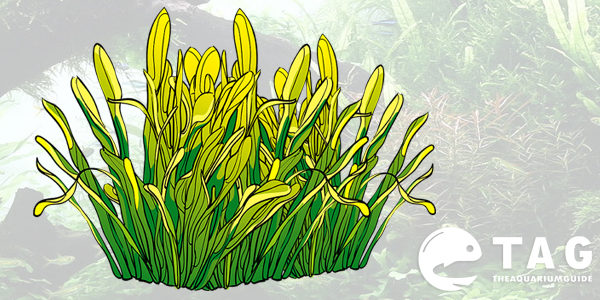
Table of Contents
Dwarf Sagittaria: A Quick Summary
Dwarf sagittaria is a small aquatic plant with a grass-like appearance. It requires moderate lighting and a nutrient-rich substrate to thrive. Dwarf sagittaria is a fast-growing plant suitable for peaceful fish tanks.
Dwarf Sagittaria Overview
| Information Chart | Dwarf Sagittaria |
| Scientific Name: | Sagittaria subulata |
| Family: | Alismataceae |
| Care Level: | Easy |
| Growth Rate: | Fast |
| Maximum Size: | Up to 12 inches |
| Minimum Tank Size: | 5 gallons |
| Water Conditions: | Freshwater |
| Lighting: | Moderate |
| Propagation: | Runner |
| Placement: | Mid-ground |
The Dwarf Sagittaria, also known as Hudson Sagittaria, Awl-leaf Arrowhead, or Ribbon Wapato, is a rapid-growing plant that produces dense clusters as it moves through your tank.
Sagittaria subulata is its scientific name, and it resembles grass with little spherical leaves. Even though each Dwarf Sagittaria is just around 4-6 inches tall, they cover the entire tank just like grass when they cluster.
Dwarf Sagittaria is a resilient plant that adapts to many water conditions and is difficult to kill. It’s an excellent plant for beginning aquarists. It grows fully immersed and partially submerged as an aquatic plant.
The Dwarf Sagittaria reproduces by producing many runners. Dwarf Sagittaria is best grown in the foreground, although you may need to replace it now and then.
More than 40 years ago, the Dutch experimented with cultivating the smaller variety of the Sagittaria, and currently, the Dwarf Sagittaria is highly popular among the aquarists.
Dwarf Sagittaria Appearance
The plant has small, arrow-like leaves ranging in size from 1 – 7 mm. The plant is 4–6 inches (10 – 15 cm) tall and bright green.
Underwater, the Dwarf Sagittaria does produce small white flowers on thin, light green stalks about 1 cm long.
Female and male flowers bloom on each stalk, with the females bearing the seeds. There are usually 1-2 female flowers and 2-5 male blooms.
When the water dries up, and the Dwarf Sagittaria is growing in the non-aquatic environment, the leaves of the Dwarf Sagittaria grow significantly larger. The leaves develop 1 to 2 inches long instead. of .04 to.28 inches (1 – 7 mm), and the stalk is considerably longer.
Dwarf Sagittaria plants are shaped like rosettes, with white roots that extend 2 to 3 inches deep into the substrate. Other Sagittaria subulata species have an identical basal rosette structure, in which the leaves create a circle at the stem base and form a rose pattern.
Types Of Dwarf Sagittaria
Tall Narrowleaf Sagittaria
This Dwarf Sagittaria cultivar grows higher than Sagittaria subulata and grows to around 20 inches.
Sagittaria Broad-Leaf
This Sagittaria is not to be confused with Dwarf Sagittaria. Sagittaria platyphylla is the correct name for it. This species develops to a bigger size, but its care requirements are similar to those of ordinary Dwarf Sagittaria.
Dwarf Sagittaria Size
When the water dries up, and the Dwarf Sagittaria is flourishing in a non-aquatic environment, the leaves of the Dwarf Sagittaria grow significantly larger. The leaves develop 1–2 inches (2.5 – 5 cm) long instead of 0.04 to 0.28 inches (1 – 7 mm), and the stalk is considerably longer.
Dwarf Sagittaria plants are shaped like rosettes, with white roots that extend 2 to 3 inches (5 – 8 cm) deep into the substrate. Other Sagittaria subulata species have a comparable basal rosette structure, in which the leaves create a circle at the stem base and form a rose pattern.
Dwarf Sagittaria Care and Tank Set-Up
This hardy plant will tolerate hard water and a high range of pH between 6.5-7.5, but many plants have thrived outside these parameters.
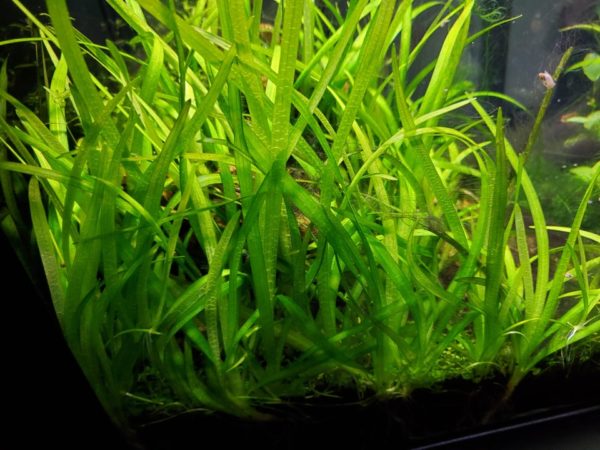
The same happens with water temperature, which should be between 72 to 82 degrees Fahrenheit, though this is only a benchmark, as many aquarists have managed to keep Dwarf Sagittaria in outdoor ponds in even lower temperatures.
Lighting should be at least 3 watts per gallon, but the Dwarf Sag will do better in stronger light. Usually, T5 or T8 bulbs are enough, but LED lighting can also be used.
At the beginning, LED lights pose some doubt, as some have not worked well, but with today’s improved technology, they are worth trying again.
Care for your Dwarf Sagittaria
Dwarf Sagittaria need to be planted in a very nutrient-rich substrate, especially containing iron. This plant is very sensitive to iron deficiencies; it will fade and become yellow if it doesn’t get enough iron.
You should always fertilize the water column if the substrate doesn’t hold enough nutrients and add some CO2 to promote height increase. They will still thrive without any CO2 supplements, but growth will be slower and mostly horizontal.
Keeping your Dwarf Sagittaria trimmed and clipped is the best way to care for it. This encourages rapid progress, allowing you to complete the desired blanket sooner. It also ensures the well-being of the Dwarf Sagittaria and the other aquarium inhabitants.
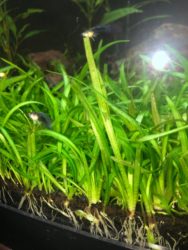
It’s also essential to look after other animals in the aquarium so that the entire ecosystem remains healthy and stress-free. It’s important to isolate Dwarf Sagittaria before adding it to an established aquarium.
If you’re adding a new fish or even shrimp to a tank that currently has Dwarf Sagittaria, quarantine the fish first before exposing it.
It’s vital to know that Dwarf Sagittaria is classified as a rosette plant, which indicates that all leaves originate from the center. When you clip the leaves, they are injured, and they will grow back smaller. You might think about the long-term repercussions of trimming as you do so. The smaller rosettes are not inherently undesirable, but it’s an outcome that you should be mindful of ahead of time.
Dwarf Sagittaria are poor at collecting nutrients from the water stream, so you’ll almost surely need aquarium fertilizer and substrate for your Dwarf Sagittaria. Furthermore, as previously said, Dwarf Sagittaria are very susceptible to an iron shortage; therefore, optimum care would entail regular iron testing and possibly iron supplementation.
Finally, keep the illumination intensity of the Dwarf Sagittaria in mind. A light that is too bright or even direct will induce discoloration or even melting. Still, a light that is too faint will force the Dwarf Sagittaria to develop taller in an unsuccessful attempt to find the light.
The light needs will also differ depending on where you want to place your Dwarf Sagittaria in the aquarium and how you intend it to grow.
Dwarf Sagittaria Tank Size and Specifications
Optimum Tank Size for Dwarf Sagittaria
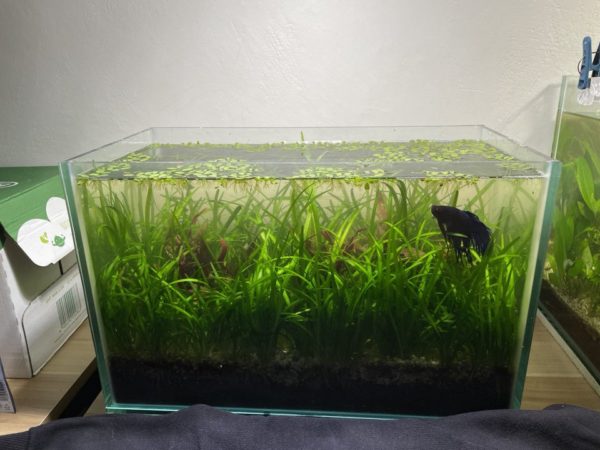
The recommended tank size for dwarf Sagittaria is a minimum of 5-gallon.
Tank Shape for Dwarf Sagittaria
Dwarf Sagittaria may be grown in a nano tank containing at least 5-gallon tank capacity, although they can also be planted in a large tank. Of course, if you’re using a smaller tank, you’ll have to prune as well as trim more often to be able to keep the plant from taking over.
Filter Type
Dwarf Sagittaria does not need any special filtration system.
Substrate
Because Dwarf Sagittaria is a root feeder, fertilizer is required to help them acquire nutrients from the water column. Both aquarium fertilizer and a substrate can be provided.
Because they are susceptible to iron deficiency, they require a nutrient-rich substrate. Yellow or discolored leaves are one indicator of iron deficiency.
It is feasible to inject carbon dioxide into Dwarf Sagittaria for greater growth, but you will need to enhance the light and fertilizer to keep the tank balanced and avoid algae bloom if you do so.
Water Parameters for Dwarf Sagittaria
Water Temperature
The ideal water temperature for dwarf Sagittaria is 20–27°C. The Dwarf Sagittaria will flourish at temperatures outside of the optimum range.
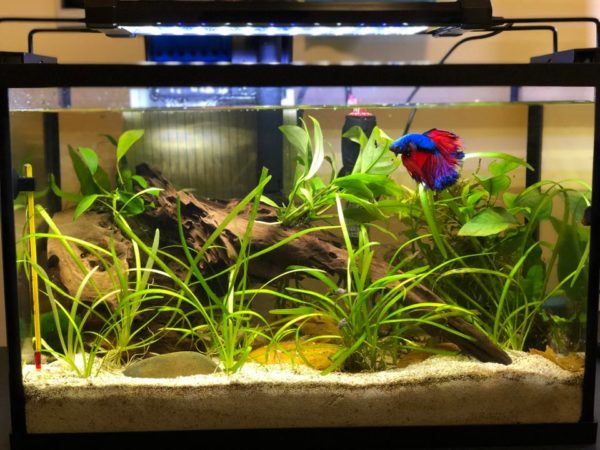
Temperature, pH, and GH are just a few variables that Dwarf Sagittaria may respond to.
Dwarf Sagittaria thrives under moderate illumination. Avoid direct sunlight, which can discolor and possibly melt the Dwarf Sagittaria.
Low light will not harm Dwarf Sagittaria, although it will slow growth and cause the plants to grow taller as they stretch for more light.
Ph Level
Although a pH of 6.0–8.0 is optimum, these plants will thrive in any environment.
Water Hardness
Hardness: They have a hardness of 2-15 GH, which means they may be used in soft and hard water.
Dwarf Sagittaria Landscape
Planting your Dwarf Sagittaria
If you want to keep this plant as a short and dense carpet, you can place it in the foreground of the tank and provide low lighting to inhibit growth. Instead, a well cared for Dwarf Sagittaria can be placed in the background of a well-lit aquarium, as strong light will help it grow higher.
The Dwarf Sags are usually placed in the middle sections of most tanks.
Having large distances between plants will make the leaves grow shorter, while planting close together will encourage vertical growth.
Reproduction
The Dwarf Sag will propagate on its own by growing runners and spreading like a thick carpet on the tank floor. If you want to control its spreading or just plant it where you planned, you can pinch off the outgrown runners and replant them in the right place.
Low light will help faster development of the runners and propagating throughout the tank, while strong light will make them grow vertically.
Runners usually grow in a few weeks after planting the first one and occasional trimming of a few leaves increases the propagation rate and favor the developing of the desirable carpet effect.
Dwarf Sagittaria Compatibility and Tank Mates
This plant can be grown next to other species like Glossostigma Elatinoides or Anubias Nana to recreate a more natural-looking environment. Also, high growing leaves can be used to create vertical accents in low set ups, next to rocks, caves, or pieces of bogwood.
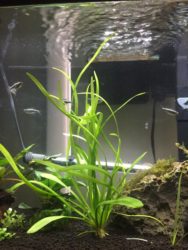
Ideal Dwarf Sagittaria Tank Mates
Depending on how you wish to curate your aquarium, you could match Dwarf Sagittaria with the plants that possess a unique growth habit, like Glossostigma, Anubias nana, or Monte Carlo.
The greatest tank mates for fish and invertebrates are tranquil organisms that won’t take or rip them apart. Snails, shrimp, and livebearers are all acceptable options. Fish that may try digging up the Dwarf Sagittaria’s roots and fish that will rip up and consume these attractive plants should be avoided.
Appropriate tank mates for the Dwarf Sagittaria:
- Black Rose Shrimp
- Blue Velvet Shrimp
- Nerite Snails
- Crystal Red Shrimp
- Japanese Trapdoor Snails
- Green Jade Shrimp
- Mystery Snails
- Orange Sakura Shrimp
- Pygmy Cory Catfish
- Vampire Shrimp
- Red Cherry Shrimp
- Amano Shrimp
- Bamboo Shrimp
- Blue Tiger Shrimp
- Cherry Barb
- Ghost Shrimp
- Green Swordtails
- Guppy
- Malaysian Trumpet Snails
- Neon Tetras
- Otocinclus Catfish
- Ramshorn Snails
- Rasboras
- Rili Shrimp
- Snowball Shrimp
Bad Tank Mates for Dwarf Sagittaria
Dwarf Sagittaria tankmates who are incompatible:
Having such narrow leaves may not be a good choice for plant-nipping fish, especially goldfish, which love to nibble at any plant.
Still, dense Sagittaria carpets would provide a good hideout for vulnerable fry or smaller fish in danger of being eaten or harassed by larger fish.
You can use Dwarf Sagittaria in a wide range of aquariums and keep it in many shapes, so experimenting is usually the best option in keeping this plant.
Its adaptability and hardiness allow for changes in the tank and even living in outdoor ponds. However, you should still monitor its development to ensure it goes well and the plant is healthy.
Propagation And Growth
The Dwarf Sagittaria may be propagated with little effort from the aquarium hobbyist. It grows on its own, and it grows swiftly. (One of the reasons the Dwarf Sagittaria is regarded as an invasive variety in many areas where it grows wild is because of this feature.)
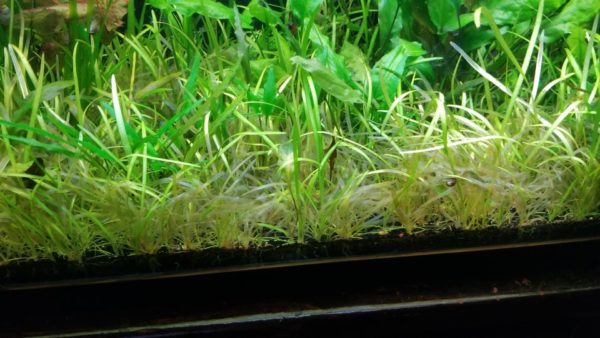
Dwarf Sagittaria runners carpet the tank’s floor. Snip the oversized runners and get to replant them wherever you want to keep the spread under control. (You can also give them to acquaintances or grow them in a separate tank, but you must first quarantine them.)
The runners will start to grow a few weeks after you plant the very first Dwarf Sagittaria. As with most plants, pruning and trimming fosters new growth and creates the lawn-like aquascape that many hobbyists desire.
The Dwarf Sag will propagate on its own by growing runners and spreading like a thick carpet on the tank floor. If you want to control its spreading or plant it where you planned, you can pinch off the outgrown runners and replant them in the right place.
Low light will help faster develop the runners and propagate throughout the tank, while strong light will make them grow vertically.
Runners usually grow in a few weeks after planting the first one. The occasional trimming of a few leaves increases the propagation rate and favors the development of the desirable carpet effect.
Benefits Of Dwarf Sagittaria
The plants aren’t just pretty to look at; they’re also good for your aquarium.
- Ambiance: It has a charming appearance and provides your aquarium with a pleasant atmosphere. They create a beautiful aquascape.
- Breeding: The carpet of the Dwarf Sagittaria will serve as a nesting ground for egg scatterers.
- Nutrients: The Dwarf Sagittaria produces biofilm, which provides food for fry and shrimplets.
- Oxygen: Dwarf Sagittaria, like other aquarium plants, helps oxygenate the water.
- Powerful roots: Dwarf Sagittaria’s strong roots clear up hazardous gas pockets that might form in your tank’s substrate.
- Refuge: Fish and invertebrates use the carpet created by the Dwarf Sagittaria to be able to take cover and hide.
What To Be Aware of Dwarf Sagittaria?
Dwarf Sagittaria are usually hardy plants, although they are vulnerable to certain modifications. Their leaves may melt if they are relocated to separate tanks and are harmed somehow.
Dwarf Sagittaria can also grow immersed (totally submerged) or emersed in water. If the circumstances of a Dwarf Sagittaria are altered from submerged to emersed or conversely, the plant may melt.
Once the Dwarf Sagittaria has adapted to the new environment, the leaves will sprout anew.
Relocation: If you must relocate your Dwarf Sagittaria, do that carefully. Pulling up the plant might harm the substrate due to its powerful roots. Cutting it off instead of tugging it up would be a better option.
Rot: Even though the Dwarf Sagittaria penetrates deep into the substrate, it will decay at the crown if it digs too deep. When this occurs, you should consider purchasing a new Dwarf Sagittaria because one with crown rot will not live since the root and stem will not absorb the vital nutrients.
Yellow leaves: An iron shortage is most likely the cause for discolored or yellow leaves. Low iron levels cause the Dwarf Sagittaria to lose its vibrant green hue, replaced with a rotting yellow.
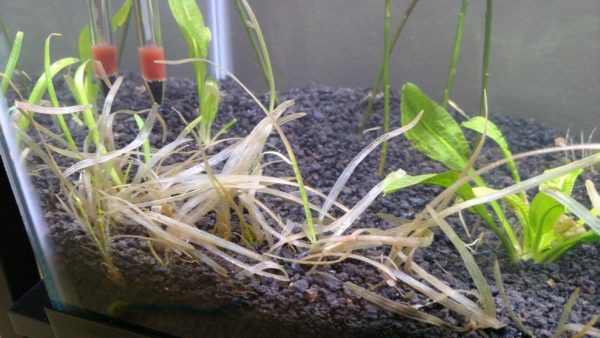
To avoid leaf discoloration, check your iron levels frequently and take iron supplements as needed.
Pro tip: Be aware of the iron requirements of your other aquarium occupants, who may become ill if excess iron is added.
Are Dwarf Sagittaria Right for You?
This is a beautiful addition to any aquarium. They are tough plants that mature rapidly and are tolerant of water parameter changes; therefore, we believe they are a wonderful live plant alternative.
FAQs
What is the maximum height of Dwarf Sagittaria?
The size of dwarf Sagittaria varies a lot. Although many varieties stay shorter than that, this plant can grow around 12 inches tall.
Is it necessary for Dwarf Sag to have root tabs?
Dwarf Sagittaria does not require root tabs. However, it will require additional nutrients if grown in brighter light with increased carbon dioxide.
Is there a requirement for substrate in dwarf Sagittaria?
Since it is a root-feeding species with roots that dig deep into the earth and spread by runners, Dwarf Sagittaria requires a thick substrate covering.
Conclusion
Seasoned aquarists adore the aquascape that the Dwarf Sagittaria does create, while rookie hobbyists love the fact that they are uncomplicated to grow and be able to care for. And your aquarium’s residents will appreciate the Dwarf Sagittaria’s numerous advantages!
Dwarf Sagittaria is an excellent choice for any planted aquarium. This aquatic plant is simple to grow, even for beginners, because it is forgiving and hardy in a wide range of water parameters. Dwarf Sagittaria is a quick-growing plant that can tolerate both full and partial submersion.
You’ll enjoy watching the leaves of the Dwarf Sagittaria emerge above the surface of the water and seeing the aquarium companions relax in the shade of this lush plant. Synthetic plants can’t compare to the spark that live plants bring to a shared tank.
You will need to watch this freshwater plant to ensure it does not get out of hand in the tank, although we think the Dwarf Sagittaria will be a welcome addition. This post will cover everything you need to know regarding Dwarf Sagittaria, encompassing how to cultivate and care for it, its benefits, and how to appreciate it as a useful element rather than a problem.
No related posts.
